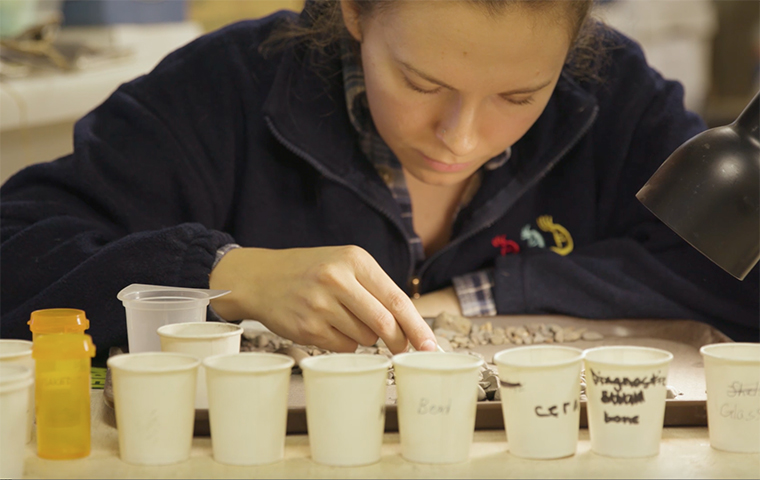
History Beneath Your Feet
Linda Hylkema and her team of archaeologists unearthed treasures from the past during the Franklin Street renovation.
Under the fresh black top and cobbled walkways of the newly converted Franklin Street corridor lies remnants of a life once lived by people from a time long ago. You may not realize it, but, you’re standing atop history.
At any given point, you may be walking over what was someone’s eating quarters where fish bones, eating utensils, and pots were recently discovered by SCU’s archaeology team before the street was converted into a pedestrian walkway. Or, you might have just stepped on one of the trolley ties from tracks dating back to the early 1900s.
Franklin Street was the site of a large Native American rancheria during the Mission Santa Clara years. The mission wasn’t just a church, but a town—a village where hundreds of people lived and built their own housing and church. They also grew and harvested their own food on site.
“When we built the parking structure and the Edward M. Dowd Art and Art History Building, we were right smack on the rancheria,” says Linda Hylkema, director of cultural resource management at Santa Clara University. “So we had stuff literally everywhere.”
Hylkema specializes in the impact of archaeology from construction and is in charge of making sure this history doesn’t get forgotten or tossed into a pile of rubble. Each time there’s a construction project on campus, she and her team are on site for months—sometimes years—in advance: excavating, discovering, and preserving the historical treasures underneath the ground.
“We do an environmental impact report for each new construction project,” Hylkema says. “It describes, in detail, how that particular project will affect cultural resources.”
One of the cultural resources that’s gathered the most public interest, according to Hylkema, are the Franklin Street trolley ties. Franklin Street used to come down where it meets the Alameda and was formerly a major thoroughfare. A popular trolley came up the Alameda and up Franklin Street to the Carmelite Monastery in Santa Clara. When the city abandoned the trolley in 1938 the wooden ties were paved over but they remained underground.
“We had to take the ties out and kept some samples of the ones that were in better shape since a lot of them had rotted underneath the ground,” Hylkema says.
The excavation team has found arrowheads, spanish pottery, glass beads, and even storage systems—telling a story of the people who left the items behind. These areas were used by Native Americans for butchering meat and firing tiles. Living quarters that resembled the adobes were also unearthed in the excavation.
“We excavated numerous subterranean pits in the ground that were used for storage of food and other goods,” says Hylkema. “When they outlived their usefulness, the pits were used for trash disposal so we have all of these artifacts that were in there.”
On Franklin Street, they also found a pottery kiln and miniature pots that Hylkema suspects were used by children as toys for pretend play since they were so small in size.
Boxes and boxes of carefully detailed findings are housed for safe keeping and for the team to process after the excavation process is finished. Everything needs to be sorted, analyzed, catalogued, and prepped for curation so that it’s archivally stable and packaged safely.
“If you’re going to take it out of the ground, you have to do something with it,” adds Corri MacEwen, the collections manager on Hylkema’s team. “You have to give it some real estate.”
An entire wing of the Ricard Observatory is dedicated to the curation all of the remnants found on Franklin Street. And, while a lot of what the team finds is here on campus, there’s an off-campus facility for the artifacts, too.
Since the Franklin Street corridor project has unearthed so much that’s gathered interest, Hylkema and her crew have teamed up with the de Saisset Museum to put them all on display this coming Fall.
On September 29, there will be a public day that commemorates the history of the project and officially opens the Franklin Pedestrian Mall to the public.